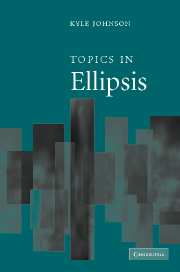Book contents
- Frontmatter
- Contents
- 1 Introduction
- 2 VP Ellipsis and constraints on interpretation
- 3 Direct compositionality and variable-free semantics: the case of Antecedent Contained Deletion
- 4 The view of QR from ellipsis
- 5 Argument Contained Ellipsis
- 6 Variable island repair under ellipsis
- 7 On binding scope and ellipsis scope
- 8 The silent content of bound variable pronouns
- 9 A step-by-step guide to ellipsis resolution
- 10 Shared constituents and Linearization
- Notes
- References
- Index
10 - Shared constituents and Linearization
Published online by Cambridge University Press: 22 September 2009
- Frontmatter
- Contents
- 1 Introduction
- 2 VP Ellipsis and constraints on interpretation
- 3 Direct compositionality and variable-free semantics: the case of Antecedent Contained Deletion
- 4 The view of QR from ellipsis
- 5 Argument Contained Ellipsis
- 6 Variable island repair under ellipsis
- 7 On binding scope and ellipsis scope
- 8 The silent content of bound variable pronouns
- 9 A step-by-step guide to ellipsis resolution
- 10 Shared constituents and Linearization
- Notes
- References
- Index
Summary
This chapter investigates basic linear properties of constituent sharing (“directional ellipsis”) in coordination, proposing an explanation in terms of Kayne's Linear Correspondence Axiom, according to which the order of words in a phrase marker is determined by c-command within that phrase marker. The explanation depends on a multiple dominance treatment of shared constituents, requiring that the Single Mother Condition on phrase markers be dropped.
Outline
Coordinate constituent sharing is realized in both “forward” (Gapping, leftward across-the-board or “ATB” movement) and “backward” (Right Node Raising) dependencies. The directionality of the dependency correlates with a constraint on the placement of “gaps” corresponding to the shared constituent α.
If a shared constituent α surfaces in the final conjunct (as in Right Node Raising), then the gaps corresponding to α in all non-final conjuncts must be at the right edge of their respective conjuncts, whereby that position must be a possible surface position for α.
If α surfaces in or to the left of the initial conjunct (as in Gapping and leftward ATB movement), then gaps corresponding to α in other conjuncts underlie no such edge restriction.
The edge condition (1a) is illustrated by the contrast in (2) (cf. Oehrle 1991). Both (2a) and (2b) involve a shared object that surfaces in the final conjunct. (2a) involves a direct object, which can stand after the PP in the first VP, i.e. it can undergo Heavy NP Shift – cf. (3a).
- Type
- Chapter
- Information
- Topics in Ellipsis , pp. 229 - 258Publisher: Cambridge University PressPrint publication year: 2008
- 3
- Cited by



